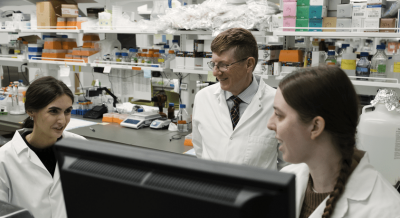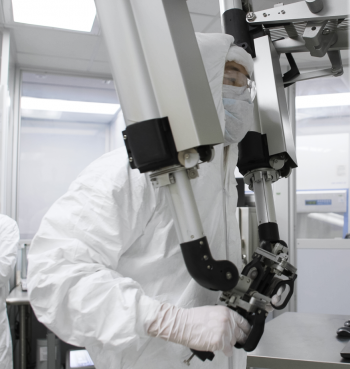When you walk up to Michigan State University’s newly renovated imaging center, one detail quietly underscores the bold vision driving Dr. Kurt Zinn’s research: the building has three separate entrances — one for humans, one for companion animals, and one for livestock. It’s a simple design choice, but it embodies a transformative idea: when it comes to fighting cancer, what helps animals can also help people, and vice versa.

Zinn, a professor jointly appointed in MSU’s Colleges of Veterinary Medicine, Human Medicine, and Engineering, is conducting cutting-edge research that exemplifies the One Health approach: a collaborative and transdisciplinary strategy that recognizes the health of people, animals, and the environment are closely connected. In the context of Zinn’s research, this connection is seen in the imaging and treatment of bladder cancer. “The canine bladder cancer model is, in many ways, a mirror of the human disease,” says Zinn. “Dogs get it spontaneously, like humans do. They live in our environment. They drink our water. It’s not like an artificially induced disease in a mouse. It’s real.”
Zinn’s team, including Drs. Jinda Fan and Satyendra Singh, is currently preparing for a clinical trial using a novel imaging agent that targets bladder cancer in both humans and dogs. The work is happening in MSU’s cleanroom-certified radiopharmacy, where researchers prepare radioisotope-labeled antibodies for imaging and, eventually, therapy. These antibodies are already FDA-approved for other cancers in humans, but in a rare and fortunate twist, they also work in dogs. “It’s unusual for antibodies made for humans to cross-react with dogs,” notes Zinn. “But in this case, the receptors are so similar that we can use the same agent in both species.”

The radioisotopes are attached to antibodies in a controlled environment so clean that recent certification tests found zero airborne particles in multiple rooms, an impressive standard even for human medical facilities. “It’s a very clean space, and everything is monitored, including temperature, humidity, and pressure,” says Zinn. “The people are the dirtiest part of the operation, so they’re in full Tyvek suits. But that’s how we ensure that what we’re preparing is sterile and safe.”
Generosity from friends of the College played a critical role in advancing this work. While this project received primary funding from Corewell Health, it was philanthropic support that made key parts of the research possible. “I’ve purchased several pieces of equipment that we used in the qualification runs that we didn’t have budget for,” says Zinn. “If we didn’t have those funds, we wouldn’t have been able to get the work done. This kind of flexible funding is exactly what we need to be innovative.”
Looking ahead, Zinn envisions expanding the use of radiopharmaceuticals in both veterinary and human medicine. He’s particularly excited about a first-in-class antibody that selectively targets tumor blood vessels and gets pumped directly into the tumor — a delivery mechanism that could revolutionize cancer imaging and therapy. “We’re hoping that this work can help treat the cancer if it’s more advanced, and also treat it in a better way from the early stage,” Zinn says. Right now, treatment helps 75% of people with bladder cancer; we think that if we add our treatments, we can get that up to 99%.” Isabelle Lynch, a graduate research assistant on this project, adds, “The hope is that long-term, this research will positively impact patients with bladder cancer (both canine and human) by providing them with a novel, effective treatment. My wish is that bladder cancer patients and their families can feel more hopeful about their therapy options.”
With continued support, Zinn sees this research impacting people and animals all over the country. “The good news is that what we’re doing is scalable,” he says. “If our approach works, it could be expanded nationally. We already have the capacity in isotope production. We just need to prove it works and build from there.”
That building — with its three entrances — might just be the blueprint for the future of cancer care.
